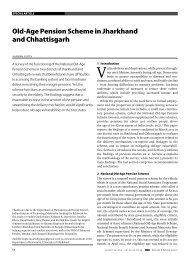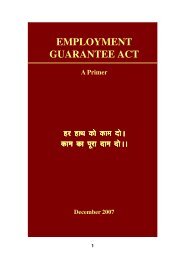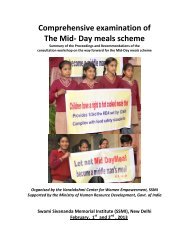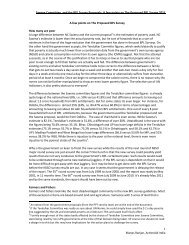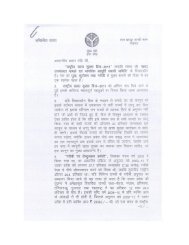NREGA: Opportunities and Challenges - Diksha
NREGA: Opportunities and Challenges - Diksha
NREGA: Opportunities and Challenges - Diksha
Create successful ePaper yourself
Turn your PDF publications into a flip-book with our unique Google optimized e-Paper software.
<strong>NREGA</strong>: OPPORTUNITIES AND CHALLENGESTable: CAG: <strong>NREGA</strong> ImplementationThe recent CAG assessment of <strong>NREGA</strong> performance has been making headlines.Media coverage has mostly projectedthe CAG report as a failure of the <strong>NREGA</strong>. Instead, a closer analysis of the findings shows that the <strong>NREGA</strong> has performedbadly due to absence of right implementation framework as well as obsessive focus on employment creation only.RequirementEmployment Guarantee Councils• States are expected to set up Rural EmploymentGuarantee scheme (REGS) <strong>and</strong> associated rulespertinent to its implementation, State EmploymentGuarantee Councils (SEGC’s) <strong>and</strong> designateEmployment Guarantee Commissioners (EGC’s)Status• 14 states did not formulate rules pertinent to implementation of the scheme.• 8 states did not designate State Rural Employment guratee Commissioners(ECGs)• 4 states did not constitute State Employment Guarantee Councils (SEGCs)Resource Support• Every State government is required to appoint a fulltime Program officer with necessary supportingstaff.• Gram Rozgar Sevak or Employment GuaranteeAssistant in each gram panchayat forimplementation of REGS.• The State Governments should constitute panels ofaccredited engineers at the District <strong>and</strong> Block Levelsfor the purpose of assisting with the estimation <strong>and</strong>measurement of works for timely approval ofprojects.• States should appoint a technical resource supportgroup at the state <strong>and</strong> district level to assist in theplanning, design, monitoring <strong>and</strong> evaluation <strong>and</strong>quality audit of the scheme.Planning• Districts are expected to prepare a five year DistrictPerspective Plan (DPP) to facilitate advanceplanning <strong>and</strong> provide a developmental perspectivefor the district.• Every village must prepare an Annual Plan.Works• Projects in low wage areas, where dem<strong>and</strong> for workat minimum wage is likely to be large, must beformulated on priority basis.• Administrative <strong>and</strong> technical sanction should beobtained for all works in advance, by Decemberprevious year.• Wage Material Ratio of 60: 40 or higher has to bemaintained at district level.• 19 states did not appoint a full time dedicated Program Officer in 89 blocks.Existing Block Development Officers were appointed as Program officers <strong>and</strong>given additional charge of the Scheme.• 18 states did not appoint Gram Rozgar Sevaks in 268 panchayts. Nonconstitutionof panels of accredited engineers in 20 states.• 23 states did not set up a Technical Resource Support Group at state ordistrict level.• The average block in 200 districts in <strong>NREGA</strong> Phase I have 20 gram panchayats<strong>and</strong> 56 villages, non-appointment of full time dedicated Program Officers,<strong>and</strong> giving additional charge to Block Development officers has severelyaffected the implementation of the scheme.• Lack of technical staff <strong>and</strong> failure to specify time frames for processing <strong>and</strong>approval of different proposals was reflected in the poor progress in takingup of works in Annual Plans.• Absence of GRAM Rozgar Sevaks severly affected the maintenance of basicrecords at the gram panchayat level, without which verification ofemployment dem<strong>and</strong> <strong>and</strong> allocation of work for each householdwas difficult.• 43 gram panchayats in 20 states did not prepare effective DPP’s. 32 districtsin 16 states continued to adopt the perspective plans made under theNational Food for Work programme (NFFWP) <strong>and</strong> failed to revise them.• 168 gram panchayats in 14 states failed to document their village annual plans.• Gram Sabhas in 91 gram panchayats in 12 states did not identify Works.• The District Plans in 8 districts in 8 states did not ensure that 50 per cent ofthe works to be executed by the gram panchayats.• Low wage areas were not identified in 53 districts in 22 states.• Administartive <strong>and</strong> Technical sanction of works was not obtained in advancein 96 gram panchayats in 12 states.• 35 blocks in 15 districts in 6 states did not follow the m<strong>and</strong>ated 60: 40 wagematerial ratio.Employment <strong>and</strong> Wages• Every person working under the Scheme is entitled towages at the minimum wage rate fixed by the StateGovernment for agricultural labourers. A districtSchedule of Rates should be prepared for each district,<strong>and</strong> should be prepared for each district.• State governments should undertake comprehensivework, time <strong>and</strong> motion studies for observing outturn <strong>and</strong> fixing wage rates, specific to ecological <strong>and</strong>geo morphological conditions.• District Schedule of Rates were not prepared in 23 states.• 46 districts in 21 states did not prepare the matrix of wage rates for the samekind of work based upon different ecological <strong>and</strong> geomorphologicalconditions.• 20 states did not udneratke any time <strong>and</strong> motion studies to observe out turnof labour.• 90 gram panchayats in 11 states paid wage rates lesser than the minimumwage rate.Note: The CAG audit covered 513 gram panchayats in128 blocks in 68 districts.Source: Performance audit of implementation of National Rural Employment Guarantee Act, 2005 (<strong>NREGA</strong>)23



